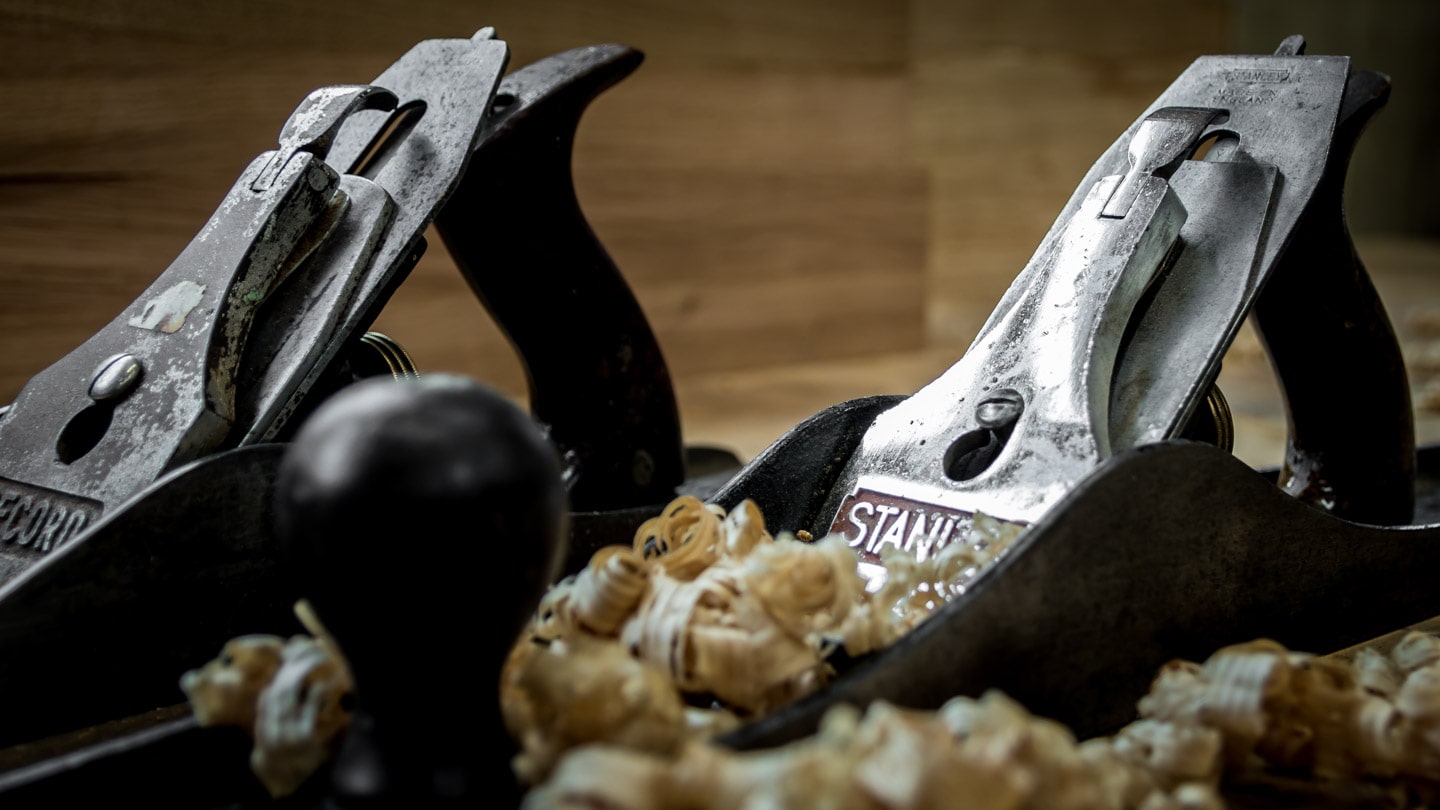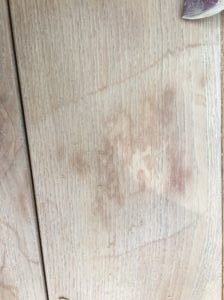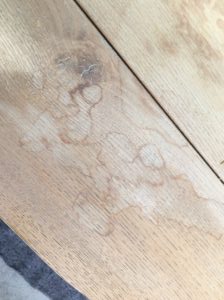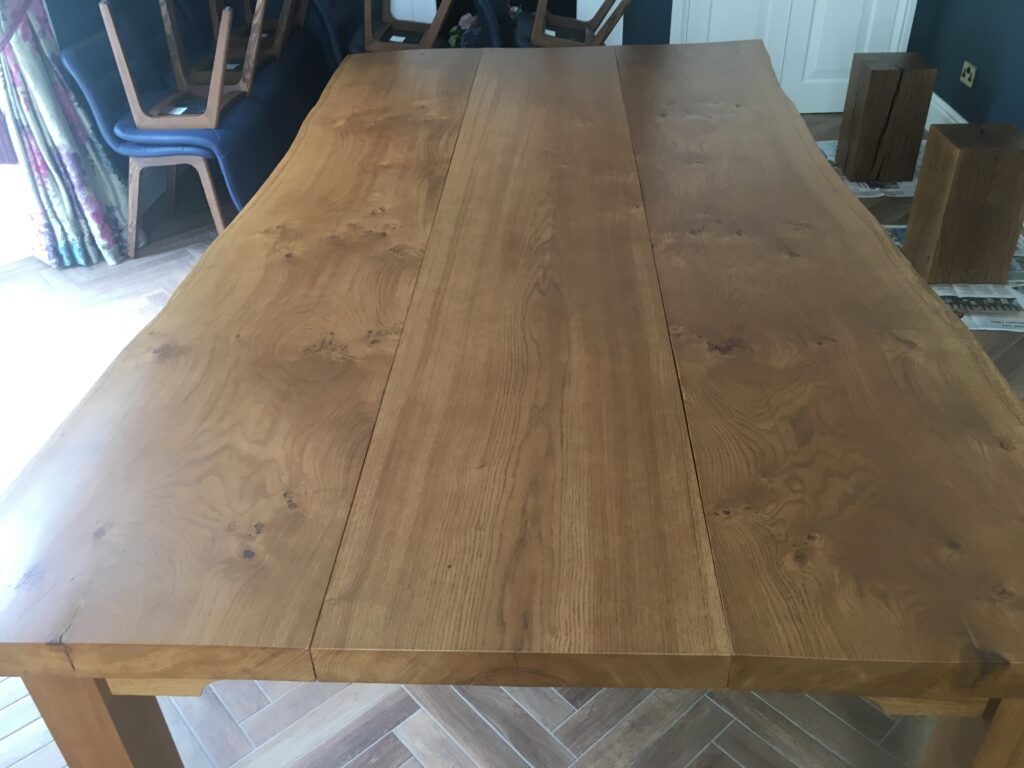Wood Movement: Part 3 – How We Deal With It

If you’ve read this article you’ll know what wood movement is and in this article I explain what you can do about it. With this knowledge you will now automatically choose a table that is going to give you much better value for your money and you will have much more accurate expectations of what to expect from your table over time.
Now, lets fast-forward 12+ months down the line from taking delivery of your table; the wood has now acclimatised to the different conditions in your home throughout the year and should not visible change much from now onwards. Depending on how lucky you’ve been, the table choices you made and the steps you’ve taken to mitigate any movement issues, you are now looking at a table that is either:
1 – Very much looking like new, nice and flat, no cracks, no wobbles.
2 – Looking a little used, maybe a few cracks or gaps here and there, edges not quite straight anymore, surface a little faded
3 – Looking worn, a bit deformed, maybe the whole top or some of the pieces bowed or twisted, big cracks opened up, surface scratched and patchy, overall pretty shabby.
If you’ve genuinely taken all the steps and made all the right decisions to mitigate wood movement, you would be unlucky to have the pretty shabby table after 1 year.
But whether your table looks just a little used, or like it’s been through a war, the settling period is now over and if you’ve chosen wisely you should be able to have your table restored, so you can love it as much as you did on delivery day, but now with very little risk of visible movement in the future.
What makes a table restorable vs disposable.
To me, a disposable table means that the cost of having its appearance restored is equal to or more than the cost of replacing the table.
Looking specifically at your table top, if it is solid wood then you may be able to have it restored. Types of restoration work are all directly related to how your wood movement might have materialised, which could be one or many of the following:
Having the table top surface finish refreshed back to new
There are generally 2 types of finish – lacquers and oils.
The benefits of lacquers are that they have good stain resistant properties and they are easy to wipe clean, needing no annual re-coating like an oil.
The compromises of lacquers are that they can still stain, they also scratch relatively easily and they can give the wood a plastic artificial-looking surface.
But the biggest negative of all is that, once a lacquer starts to look shabby with use (stains, scratches, patchy appearance where it is heavily used) a lacquer cannot be repaired, or touched up – the whole surface has to be stripped back to bare wood and re-finished. The cost of having this work done can add up to as much as the cost of just replacing the table top or, depending on how the table was made, replacing the whole table.
So the headline here is – be very wary of lacquered tables, or at least understand that you’ll have to tolerate a shabby looking table if you don’t want to spend a good amount restoring or replacing it.
Oiled finishes on the other hand, can be repaired, touched up and restored. The stain resistant properties in many cases do not measure up to lacquers, but as they need a fresh coat of oil once a year or so, unless you have some very deep staining, in many cases you can do this yourself and at the same time remove any marks and restore the surface back to new. Indefinitely.

This table had never been re-oiled so the finish had completely worn away, leaving the surface faded and showing a build-up of staining from several years of use.

Another area of heavy staining on the same table

This is the same table after sand and re-oil in-situ by the Abacus service team
We use an extremely high performance sprayed oil finish called Induro™, which offers stain protection as good as a lacquer but keeps the surface looking and feeling natural, whilst also being repairable and easy to re-coat by hand if / when you want to refresh the surface. It is also a lot more scratch resistant than a lacquer and any other oil we’ve ever used (and believe me we’ve tested a lot!), meaning your table surface will stay looking lovely for a lot longer than with any other finish, and it is very easy to keep clean. Even in a commercial setting I always recommend this finish, which we stain tested over the last 18 months and have yet to have a single issue.
Having gaps closed or edges straightened
If your table top is more than 1 individual piece of timber in a plank style (i.e. not a single-piece smooth top), as each piece of timber acclimatises it can shrink a little to create gaps between the pieces. The shrinkage is unlikely to be even, so it may also highlight that the edges of pieces may no longer be straight.
You might like this rustic look, so no action required. But if you want those gaps closing up and edges straightening, it is essential that the maker has used a joint design that allows the top pieces to be removed and easily re-aligned.
We do not use any wood screws or permanent glued joints that cannot be broken in our tables. Instead, the parts of our tables are held together useing stainless steel threads and bolts, so they do not corrode and ensuring any component can be removed, refurbished and replaced with just as solid a joint as when the table was new. For that reason we are able to offer a guarantee that if you have these issues you will receive a free service visit after the settling period where we’ll close up any gaps and straighten any edges that need it. You can read more here about our aftercare service.

A Farmhouse table with wide oak slabs, you can see how the gaps have opening up in the initial 12 months acclimatising as well as some of the pieces losing their level.

If you’re buying a table direct from another workshop you should ask the maker how they will deal with gaps or wavy edges. You now know that “don’t worry you wont have that problem” is a guarantee that nobody can give so their response should give you complete peace of mind.
If you’re buying from a shop, who will have likely imported it from a factory overseas, chances are you wont be able to remove the pieces without pulling the table apart and destroying some of the joints. This, to me, makes the table disposable.
Having splits or cracks filled
This is a big one because it is very common – a solid wood table, especially a more chunky one, should be made with joints that allow the wood to move freely. You cannot stop wood doing what it wants to do (the wood is not a person John), so if you constrain it with uncompromising fixed joints then it will move in areas away from the joints and the movement can be more exaggerated as a result which means splitting between pieces of jointed wood and cracking within pieces of wood.
We designed our own free-moving stainless steel slotted joint plate that holds our tables together rigidly whilst allowing every individual piece of timber to move freely as it acclimatises throughout the year.
Joints that allow wood movement are essential to minimise the risk of issues, but nevertheless timber can still split and crack just from trying to acclimatise to its environment. In fact, cracking in wide, thick pieces of timber is very difficult to avoid so tables can often have filled cracks even when new, just from the kiln drying process.
Unfortunately, there isn’t much that can be done to close up a crack so the only option (if you don’t want to cut out the crack and crate a joint in the middle of a piece) is to fill it.
This brings us back to the same challenges as refinishing a table – if a table has been lacquered then to fill any cracks and restore the finish, the whole top needs to be stripped back to bare wood and lacquered again. Huge cost, arguably more than just replacing the table and starting back where you were 12 months ago with the same risks of movement again.
If the table is oiled, then filling and refinishing is no problem.
Not only do we finish our tables with a high performance sprayed oil finish, as part of the aftercare that come with every table, if you have any new or open cracks after the oak has settled you’ll receive a service visit where we’ll fill the cracks and refinish the table surface.
Having twisted or bowed pieces flattened
Flattening twisted or bowed pieces is the most difficult task with a table, especially a big thick one. I’ll repeat here that if you have underfloor heating then you are the greatest risk of this happening.
You cannot mechanically force a bent piece of wood flat again, so the only method is to plane away the surfaces bit by bit until the piece looks flat again, which is the exact same process used when taking kiln dried wood to make a new table. So there will be material loss, the piece will end up a little thinner and maybe a little narrower depending on how much it has moved (length should not be affected).
A bow or twist can render a table unusable, so if you have this issue then action is required and replacement or restoration are your only options. For the top, or piece of the top, to be restorable we go back to the same challenges of straightening edges and closing gaps – the table top must be removable without destroying any permanent joints.
So, once again, if you buy the table from a retailer rather than a workshop, it is likely going to be cheaper to replace the whole table than have the top removed, restored and refitted, just because of the nature of mass produced furniture.
If you buy from a workshop then not only do you need to ensure they are making a table that can be disassembled, restored and re-assembled, but also that they have the knowledge and equipment to undertake the work for you. Then if they are able to do it, are they willing to do it without charge because if not it is a very time-consuming process, not to mention the cost of collecting and returning the table after the work.
I’ve already explained that with any of our tables, if you have gaps, uneven edges, splits or cracks then we will restore those for you as part of our aftercare service.
Well, if you have taken the steps I recommend in this article to minimise the risk of movement in your home environment, we guarantee that if your table top, or any individual piece, twists or bends then after the settling period of 12 months we will collect your table for a complete restoration at our workshop and return it to you. All completely free of charge.
A Maker that Supports You
I hope you can now see the direct link between where you buy your table and your long term happiness, value and satisfaction you get from your table. The combination of how a solid wood table is made and the aftercare that the maker is willing to provide, is the difference between your table being disposable and giving you a long and happy life together.
Wood movement, or natural movement, is for me THE most important thing to know about when buying a real wood table but in all the time we’ve been designing and building tables I have not come across a single retailer or workshop who explains the issue and potential aesthetic consequences to their customers.
What I have come across consistently, is a sentence or paragraph in the terms and conditions of every furniture retailer and maker that exonerates them from any responsibility to address movement issues. It usually goes something like this “wood is a natural material and we can not be held responsible for any issues that result from natural wood movement”. In my experience there are very few issues that a table can have that are not a result of wood movement, which to me renders most table guarantees worthless and not giving you any protection with your purchase.
Every retailer and maker knows about wood movement, they hide it and therefore leave it to pure chance how long you will be satisfied with your table. There isn’t even any education on how to take steps to optimise your home environment for a solid wood table. There certainly isn’t any warning about the compromises and potential costs of restoring or replacing a lacquered table top.
But because we have always stood by our customers, even long before we understood the many factors affecting wood movement, we have learned over many years how to choose materials and design tables to minimise the chances of our customers experiencing movement problems. And because we take all of these steps, we have the confidence to offer an aftercare service unlike any other and a guarantee that, if you take the simple steps we recommend, any movement issues you do experience with one of our tables will be restored free of charge.
Our tables come with complete peace of mind.
